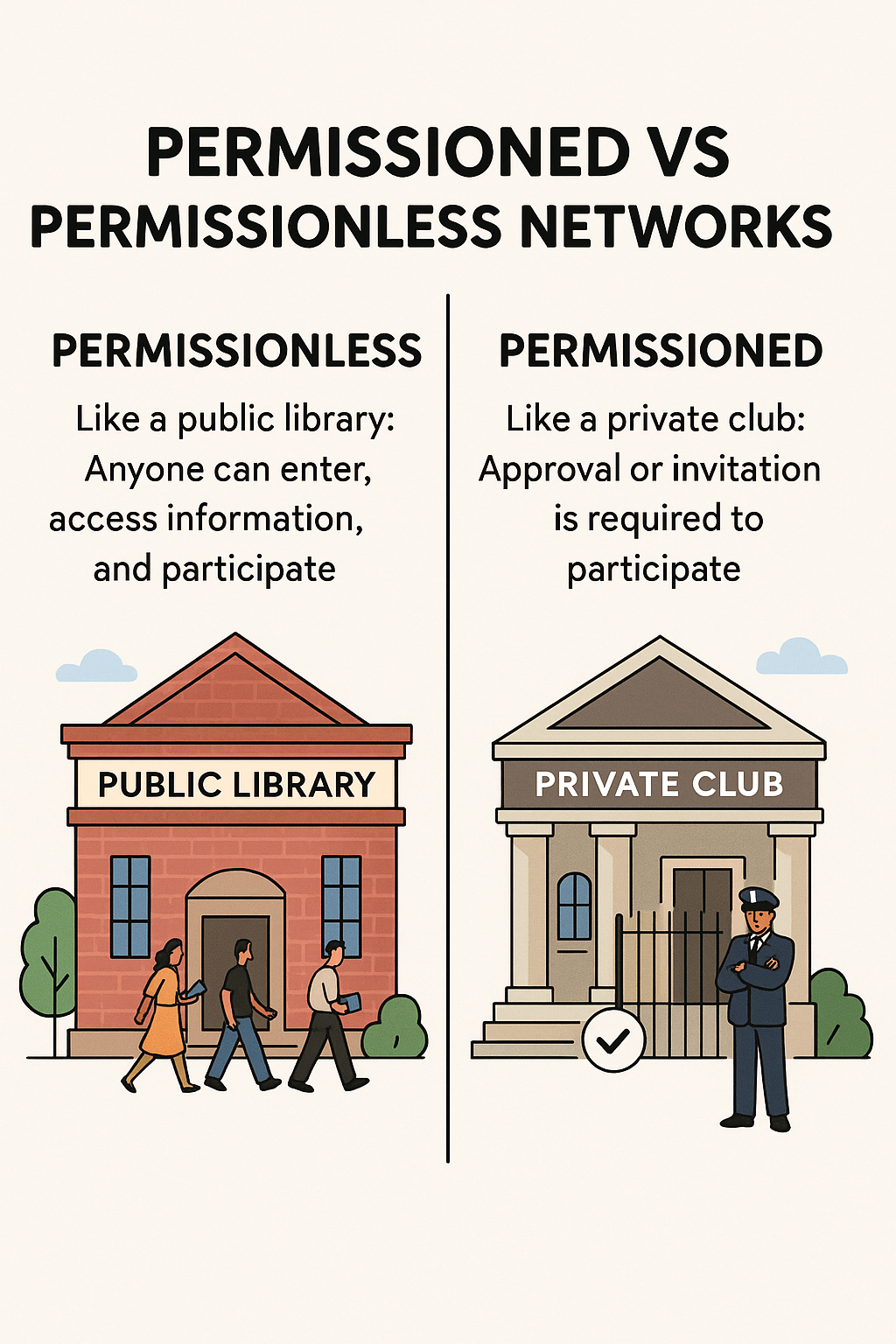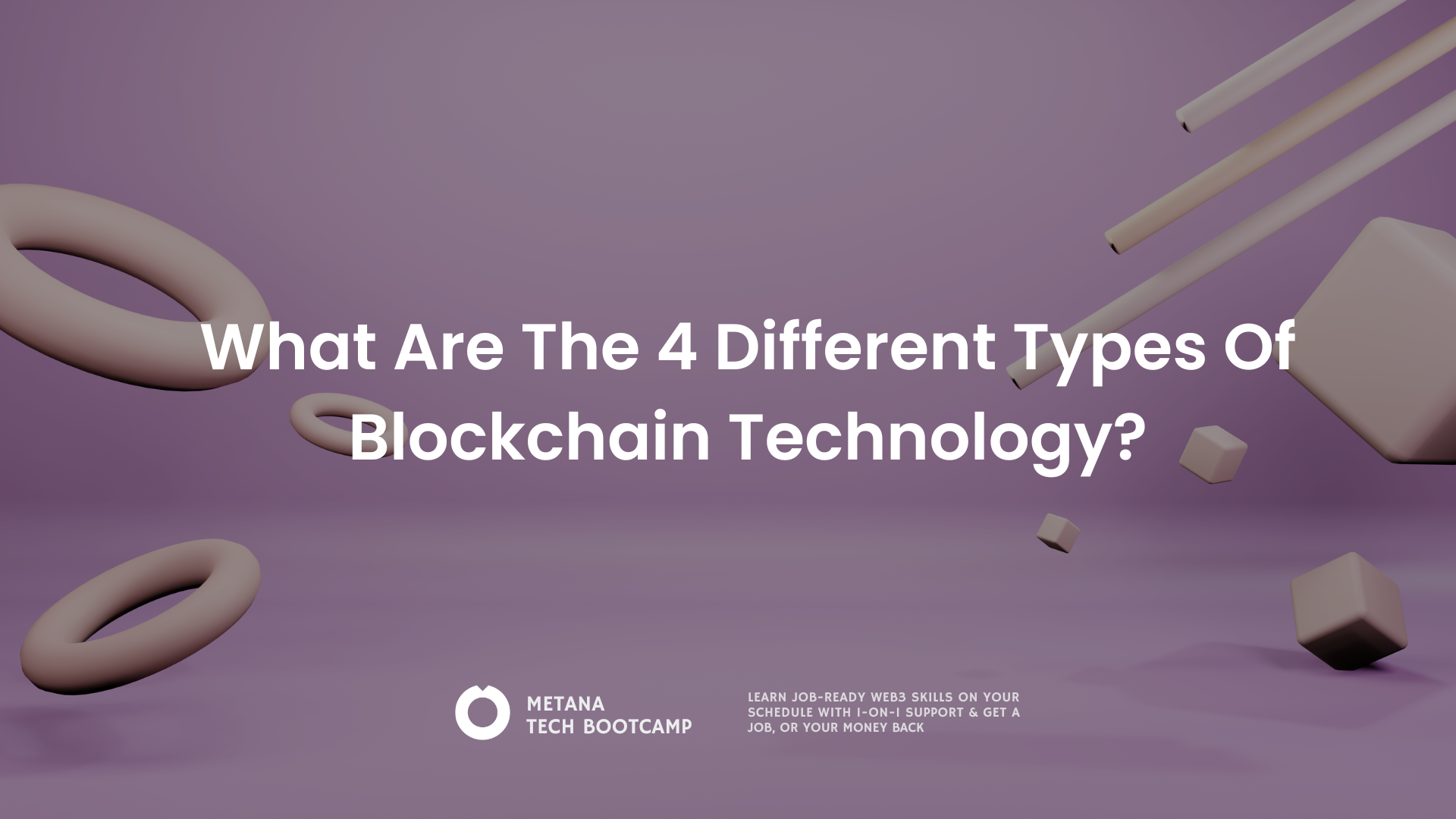TL;DR
- Public blockchains are completely open and decentralized (Bitcoin, Ethereum)
- Private blockchains are controlled by single organizations for internal use
- Hybrid blockchains combine public transparency with private control
- Consortium blockchains are governed by groups of organizations working together
- Choose based on your needs for privacy, control, speed, and regulatory compliance
- Implementation success depends on technical expertise and clear business requirements
Blockchain technology isn’t one-size-fits-all. You’ve got four different types of blockchain networks, each designed for different business needs, privacy requirements, and operational goals. Understanding these differences can save you from costly implementation mistakes and help you choose the right blockchain foundation for your project.
Understanding Blockchain Technology Fundamentals
Before diving into the four types, you need to grasp the core distinction that separates all blockchain networks.
Permissioned vs Permissionless Networks

Think of blockchain networks like buildings with different access controls.
Permissionless blockchains are like public libraries. Anyone can walk in, access information, and participate in activities. No background check required.
Permissioned blockchains operate more like private clubs. You need approval, credentials, or an invitation to participate. Someone controls who gets access and what they can do inside.
Why Blockchain Type Matters for Your Business
Your choice of blockchain type directly impacts:
- Privacy levels for your data and transactions
- Transaction speed and network performance
- Control over network governance and changes
- Compliance with regulatory requirements
- Cost of implementation and maintenance

Get this decision wrong, and you’ll face expensive migrations or regulatory headaches down the road.
Now let’s examine each type in detail.
1. Public Blockchains
Public blockchains are the original blockchain vision – completely open, decentralized networks where anyone can participate without permission.
Key Characteristics and Benefits
Complete Decentralization: No single entity controls the network. Thousands of computers worldwide maintain the system, making it nearly impossible to manipulate or shut down.
Transparency: Every transaction is visible to all participants. You can trace any transaction from beginning to end, creating unprecedented accountability.
Global Accessibility: Anyone with internet access can join, send transactions, or build applications on top of the network.
Immutability: Once data is recorded and confirmed by the network, it’s extremely difficult to alter or delete.
PRO TIP:
Public blockchains offer the highest level of decentralization, but this comes at the cost of speed and energy consumption.
Real-World Examples and Use Cases
Bitcoin remains the most famous public blockchain, processing millions of dollars in transactions daily without any central authority.
Ethereum powers thousands of decentralized applications (dApps), from decentralized finance (DeFi) protocols to non-fungible token (NFT) marketplaces. If you’re interested in building on Ethereum, check out our guide on implementing a blockchain with JavaScript.
Ethereum powers thousands of decentralized applications (dApps), from decentralized finance (DeFi) protocols to non-fungible token (NFT) marketplaces.
If you’re interested in building on Ethereum, check out our guide on implementing a blockchain with JavaScript.
Public blockchains excel in:
- Cryptocurrency transactions and digital payments
- Decentralized finance (DeFi) applications like lending and trading
- NFT marketplaces and digital asset ownership
- Crowdfunding and tokenized fundraising
- Open-source development projects requiring transparent collaboration
Limitations and Challenges
Scalability Issues: Bitcoin processes only 7 transactions per second, while Ethereum handles about 15. Compare this to Visa’s 24,000 transactions per second.
Energy Consumption: Proof-of-work consensus mechanisms consume massive amounts of electricity. Bitcoin’s annual energy usage rivals that of entire countries.
Privacy Concerns: Complete transparency means anyone can track transactions and potentially link them to real identities.
Regulatory Uncertainty: Government responses to public blockchains remain inconsistent across different jurisdictions.
2. Private Blockchains
Private blockchains flip the script on openness, creating closed networks controlled by single organizations or entities.
Core Features and Advantages
Restricted Access: Only authorized participants can join the network, read data, or submit transactions.
Enhanced Privacy: Sensitive business information stays within the organization, away from public view.
High Performance: With fewer participants and simpler consensus mechanisms, private blockchains can process thousands of transactions per second.
Regulatory Compliance: Easier to meet industry-specific regulations when you control all aspects of the network.
Cost Efficiency: Lower computational requirements mean reduced operational costs compared to public networks.
Business Applications and Examples
Walmart uses a private blockchain to track food products through its supply chain, enabling rapid identification of contamination sources during food safety incidents.
JPMorgan’s JPM Coin operates on a private blockchain network to facilitate institutional payments between the bank’s clients.
Private blockchains work best for:
- Internal record keeping and audit trails
- Supply chain tracking within controlled networks
- Financial settlements between known parties
- Healthcare data management with patient privacy requirements
- Government applications requiring citizen data protection
Security and Scalability Considerations
Single Point of Failure: The controlling organization becomes the weakest link. If they’re compromised, the entire network is at risk.
Trust Requirements: Participants must trust the controlling entity to operate the network fairly and maintain security.
Limited Innovation: Closed ecosystems may struggle to benefit from broader developer communities and open-source innovations.
3. Hybrid Blockchains
Hybrid blockchains attempt to capture the benefits of both public and private networks through selective transparency and customizable access controls.
How Hybrid Networks Function
Imagine a building with both public areas (like a lobby) and restricted zones (like executive offices). Hybrid blockchains work similarly.
Public Components: Certain data and transactions remain visible to everyone, providing transparency where needed.
Private Components: Sensitive information stays restricted to authorized participants only.
Controlled Access: Organizations can grant different permission levels to various user types.
Selective Disclosure: Companies can choose what information to make public and what to keep private.
Real Use Cases and Implementation
Healthcare Systems: Patient data remains private, but research findings and drug trial results can be made publicly auditable.
Government Services: Voting results and public spending can be transparent while citizen personal information stays protected.
Financial Services: Transaction settlements between banks can be private, but regulatory reporting remains publicly auditable.
Real-world example: XinFin Network combines Ethereum’s public blockchain with private network capabilities, allowing businesses to keep sensitive data private while maintaining public transparency for stakeholder verification.
PRO TIP:
Hybrid blockchains offer the most flexibility, but require careful planning to balance transparency with privacy needs.
Management Complexity and Costs
Technical Complexity: Managing dual public and private components requires sophisticated infrastructure and expertise.
Governance Challenges: Decisions about what should be public vs. private can create internal conflicts and slow development.
Higher Development Costs: Building and maintaining hybrid systems typically costs more than single-type implementations.
Integration Difficulties: Connecting public and private components while maintaining security requires careful architecture planning.
4. Consortium Blockchains
Consortium blockchains represent a middle ground between private and public networks, with control shared among a group of organizations rather than concentrated in a single entity.
Multi-Organization Control Structure
Think of consortium blockchains like industry trade associations. Multiple companies work together, sharing control and decision-making responsibility.
Shared Governance: Network decisions require consensus among consortium members, preventing any single organization from dominating.
Distributed Trust: Instead of trusting one company, participants trust a group of established organizations.
Collaborative Benefits: Members can share costs, risks, and technical expertise across the consortium.
Industry Focus: Most consortium blockchains serve specific industries or use cases where collaboration creates mutual benefits.
Supply Chain and Banking Applications
R3’s Corda connects banks worldwide, enabling secure transaction processing and information sharing while maintaining individual bank privacy.
IBM Food Trust brings together retailers, suppliers, and growers to track food products from farm to table, improving safety and reducing waste.
Maersk TradeLens connects shipping companies, ports, and logistics providers to streamline global trade documentation and tracking.
Consortium blockchains excel in:
- Supply chain management across industry partners
- Banking and financial settlements between institutions
- Insurance claim processing among multiple insurers
- Healthcare data sharing between hospitals and research institutions
- Energy trading among utility companies
Coordination Challenges and Solutions
Consensus Difficulties: Getting multiple organizations to agree on network changes can slow development and adaptation.
Conflicting Interests: Member organizations may have competing business goals that complicate collaboration.
Exit Risks: If key consortium members leave, it can destabilize the entire network.
Standardization Issues: Different organizations may prefer different technical standards, creating integration challenges.
Solutions include:
- Clear governance frameworks established upfront
- Defined dispute resolution processes
- Technical standards committees
- Gradual onboarding of new members with established protocols
How to Choose the Right Blockchain Type
Selecting the right blockchain type requires honest assessment of your specific needs, constraints, and goals.
Business Requirements Assessment
Start by answering these critical questions:
Privacy vs. Transparency: Do you need complete transparency for stakeholder trust, or must sensitive data remain private?
Control vs. Decentralization: Do you need full control over the network, or can you benefit from shared governance?
Speed vs. Security: Are you processing high transaction volumes that require speed, or is maximum security your priority?
Cost vs. Features: What’s your budget for implementation and ongoing maintenance?
Compliance Requirements: What regulatory standards must you meet in your industry and jurisdiction?
Here’s a quick decision framework:
- Choose Public if you need maximum transparency, decentralization, and global accessibility
- Choose Private if you require complete control, high privacy, and fast processing speeds
- Choose Hybrid if you need selective transparency with controlled access to different data types
- Choose Consortium if you’re collaborating with industry partners who share costs and governance
PRO TIP:
Most successful blockchain implementations start with a clear problem statement. If you can’t articulate the specific problem blockchain solves for your business, you’re not ready to choose a type.
Regulatory and Compliance Factors
Different blockchain types face varying regulatory scrutiny:
Public Blockchains may face restrictions in highly regulated industries like banking and healthcare due to data privacy requirements.
Private Blockchains often align better with existing compliance frameworks but may not provide sufficient transparency for some regulatory requirements.
Hybrid and Consortium blockchains offer the most flexibility for meeting complex regulatory requirements across different jurisdictions.
Consider these compliance factors:
- Data residency requirements in your target markets
- Industry-specific regulations (HIPAA, SOX, GDPR, etc.)
- Financial services regulations (KYC, AML requirements)
- Cross-border data transfer restrictions
- Audit and reporting requirements
Implementation Considerations and Next Steps
Once you’ve identified the right blockchain type, focus on these implementation success factors:
Technical Expertise: Do you have blockchain developers in-house, or will you need external partners? If you’re looking to develop blockchain skills, consider exploring Web3 bootcamps and courses to build your team’s capabilities.
Infrastructure Requirements: What hardware, software, and network infrastructure changes will you need?
Integration Planning: How will the blockchain connect with your existing systems and databases?
User Training: What education will your team and users need to adopt the new system?
Performance Monitoring: How will you measure success and identify areas for optimization?
Scalability Planning: How will the system handle growth in users, transactions, or data volume?
Quick Glimpse Of The Four Types Of Blockchain Technology!
| Type | Access Control | Governance | Use Cases | Pros | Cons |
|---|---|---|---|---|---|
| Public | Open to anyone (permissionless) | Decentralized (no central authority) | Crypto, DeFi, NFTs, open-source projects | High transparency, decentralization, global access | Low speed, high energy use, limited privacy, regulatory issues |
| Private | Restricted to approved users | Single organization | Supply chains, internal audits, banking, healthcare | High speed, privacy, easy compliance, low energy usage | Centralized trust, limited innovation, single point of failure |
| Hybrid | Mix of public and private access | Controlled by one or more entities | Healthcare, government, enterprise data sharing | Flexibility, selective transparency, controlled access | Complex to manage and integrate, higher development costs |
| Consortium | Limited to member organizations | Shared among multiple parties | Banking, supply chains, insurance, energy trading | Shared cost/risk, collaborative control, industry-focused | Governance conflicts, slower decision-making, integration issues |
Finally
Before making any implementation decisions, make sure to conduct thorough blockchain research to validate your approach and understand the technical requirements fully.
The blockchain landscape continues evolving rapidly. The type you choose today should align with your current needs while providing flexibility for future requirements.
Your next step is conducting a thorough requirements analysis with your technical team, legal advisors, and key stakeholders. This collaborative approach ensures your blockchain type selection supports both immediate goals and long-term strategic objectives.
Remember: the best blockchain is the one that solves your specific business problem efficiently and sustainably. For those interested in deepening their blockchain knowledge, our recommended blockchain books provide excellent resources for both beginners and experts.
Frequently Asked Questions
Can I change my blockchain type later if I pick the wrong one?
Yes, but changing can be complex and expensive. It usually involves rebuilding your applications, migrating data, and retraining your team. It is much better to choose the right type from the start to avoid these challenges.
What is the most affordable blockchain option for small businesses?
Private blockchains often offer the lowest ongoing costs because they require less computing power and are easier to manage. However, initial development costs may be higher unless you use existing platforms.
Do all consortium blockchain members have to use the same technology?
No. Most consortium blockchains use standard protocols and APIs that allow each member to operate their own systems while staying connected to the network. This allows flexibility while maintaining interoperability.
How do hybrid blockchains keep private data secure if some parts are public?
Hybrid blockchains separate public and private components. They use cryptographic techniques like zero knowledge proofs to validate public data without revealing the sensitive information behind it.
Are public blockchains practical for real world business use?
Yes, especially for use cases that benefit from transparency and decentralization such as supply chain tracking, digital identity verification, or community based rewards. However, they may not be ideal for situations requiring privacy or fast transaction processing.








